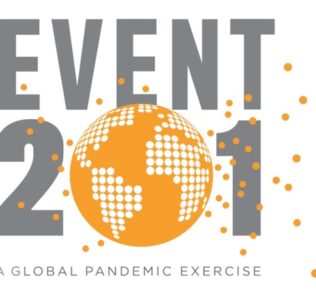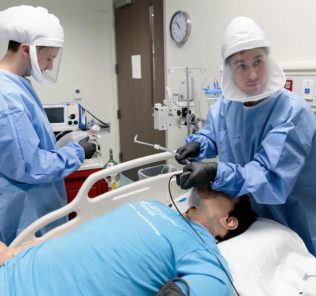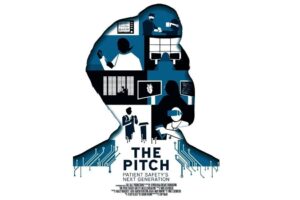Monkeypox for Healthcare Simulation: Moulage & Resources
Of the many lessons learned from the COVID-19 pandemic, one that was clear remains that healthcare simulation can be used to help medical professionals train for these types of large-impact infectious diseases. From simulating how such a disease could spread from location to location to training healthcare staff on how to respond to infected patients, the practice of medical simulation has proved extremely beneficial. As world health leaders now shift their attention to the increasing number of Monkeypox infections globally, they must remember the usefulness of healthcare simulation – from moulage to task trainers and even virtual reality simulation. This HealthySimulation.com article shares a number of ways medical professionals can once again call on clinical simulation to prepare for growing Monkeypox outbreaks.
The World Health Organization (WHO) describes Monkeypox as an orthopoxvirus that causes a disease with symptoms similar, but less severe, to smallpox. “While smallpox was eradicated in 1980, monkeypox continues to occur in countries of central and west Africa.” A zoonosis, the disease is transmitted from animals to humans, and cases are often found close to tropical rainforests where there are animals that carry the virus.
The WHO further explains that Monkeypox can be transmitted through contact with bodily fluids, lesions on the skin or on internal mucosal surfaces, such as in the mouth or throat, respiratory droplets, and contaminated objects. The organization notes that the best diagnostic specimens currently identified are directly from the rash – skin, fluid, or crusts, or biopsy where feasible. (Antigen and antibody detection methods may not be useful as they do not distinguish between orthopoxviruses.)
Sponsored Content:
Ways Healthcare Simulation Can Help Medical Leaders Prepare
Should the spread of Monkeypox become an endemic and infection become a threat to millions of people worldwide, healthcare leaders should seize the opportunity to determine means of optimal preparedness. One use of medical simulation is training clinicians and other healthcare staff members on ways to identify Monkeypox cases based on the disease’s symptoms. Whether by using a simulated patient or virtual reality scenarios, clinical simulation can help leaders associate the symptoms of fever and rash with positive cases.
Geared less toward training preparedness and more toward evaluating the spread of a disease, a tabletop exercise can be useful when trying to determine the threat level of a virus such as Monkeypox. Interestingly, in 2021, an international biosecurity conference in Munich held a simulation of a “global pandemic involving an unusual strain of Monkeypox.” According to an article by Intellectual Takeout, “The global Monkeypox outbreak—occurring on the exact timeline predicted by a biosecurity simulation of a global Monkeypox outbreak a year prior—bears a striking resemblance to the outbreak of COVID-19 just months after Event 201, a simulation of a coronavirus pandemic almost exactly like COVID-19.”
Monkeypox Moulage
Another way learners can be trained to identify Monkeypox is through the use of healthcare simulation moulage. Moulage is originally a French word for molding but in modern times has become synonymous with the application of simulated illnesses or wounds on a manikin in order to better train healthcare professionals. Specifically, as the practice relates to the possible identification of Monkeypox, healthcare leaders can use materials to simulate the Monkeypox rash and blisters. utilized with medical simulators in-order to provide assessment clues to healthcare students and professionals.
Sponsored Content:
“Monkeypox, like most rashes, initially mimics other disease processes from a moulage perspective. The application of a flat, reddened rash and swollen (palpable) lymph nodes presented alongside flulike symptoms provide pivotal cues in identification and triage,” said Bobbie Merica, CEO, and founder at Moulage Concepts Inc. “When advancing scenarios to include PPE, immersive moulage including odorous pus-filled blisters and dried scabs will rely heavily on application standardization, whether using gels, silicones, or our 3Dimensional training tattoos to save time between scenario setup.”
“Understandably Monkeypox will be included in clinical scenarios as clinicians rapidly prepare to manage patients exhibiting its symptoms. Medically accurate moulage will form a useful part of this training,” explained Nola Pearce, the managing director at TraumaSim and president of Military Moulage Combat Injury Simulation. “Any rashes can be created in moulage and monkeypox is no different. As a starting point it’s important to seek clinical photos to ensure accuracy. Then looking with a critical eye get a mental image of the dimensions and color of the lesions and surrounding skin that you are trying to create.”
She added that the lesions can be recreated directly onto a standardized patient or manikin with the silicone or moulage of choice, or they can be premade and applied as needed taking careful note of the color of intact or broken vesicles. She recommended the educator consider the desired clinical outcomes. (Ie. Is the scenario being used as a triage exercise where the blisters won’t be touched? Or is the moulage meant to represent an actual treatment where the clinician will be dressing open blisters?) If the rash is to be treated consider filling the blisters with a suitable liquid. Further, she says, like in any clinical scenario, ensure the standardized patient displays all of the appropriate symptoms to complete the picture.
Why Healthcare Simulation is Imperative for Situational Preparedness
Given the examples brought forth by COVID-19 simulation, and the reported Monkeypox tabletop exercise, healthcare leaders must begin to increasingly rely on medical simulation to bring awareness of the true scale of potential threats. Using healthcare simulation to strengthen global systems can also help to prevent and respond to high-consequence biological threats. Whether a simulation scenario determines whether a virus will or will not become the next pandemic, endemic, or the like, knowing what could be coming is key to determining appropriate action.
Adding to this point, in April 2021, HealthySimulation.com Founder and CEO Lance Baily published the article “Why Healthcare Simulation is About to Become One of the World’s Most Important Industries.” This article explained how pandemic readiness is critical, and how healthcare simulation is primed for a transition to mass adoption. He recalled a letter in which Bill and Melinda Gates share several innovative strategies for overcoming future pandemics, including the creation of a specialized group of about 3,000 “Infectious Disease Responders” who will be ready at a moment’s notice to travel and contain outbreaks around the world.
In many ways, this concept accurately depicts how organizational leadership turned to clinical simulation programs to help them overcome restrictive training limitations during the early days of COVID-19. Through the use of these resources, clinicians were able to save patient lives, prepare for overflow tent patient care, simulate vaccination processes, build innovative ventilator tools, and much more.
“With the realization that countries and healthcare systems can invest just a few billion dollars in preparedness annually to save against trillions from the next pandemic, we can easily see how it is only a matter of time before the healthcare industry completely reboots itself to be based almost entirely on simulation to educate learners, train professionals, find systemic errors, and improve outcomes,” Baily writes.
Learn More About Healthcare Simulation Pandemic Readiness
Lance Baily, BA, EMT-B, is the Founder & CEO of HealthySimulation.com, which he started while serving as the Director of the Nevada System of Higher Education’s Clinical Simulation Center of Las Vegas back in 2010. Lance is also the Founder and acting Advisor to the Board of SimGHOSTS.org, the world’s only non-profit organization dedicated to supporting professionals operating healthcare simulation technologies. His co-edited Book: “Comprehensive Healthcare Simulation: Operations, Technology, and Innovative Practice” is cited as a key source for professional certification in the industry. Lance’s background also includes serving as a Simulation Technology Specialist for the LA Community College District, EMS fire fighting, Hollywood movie production, rescue diving, and global travel. He and his wife Abigail Baily, PhD live in Las Vegas, Nevada with their two amazing daughters.
Sponsored Content:

















